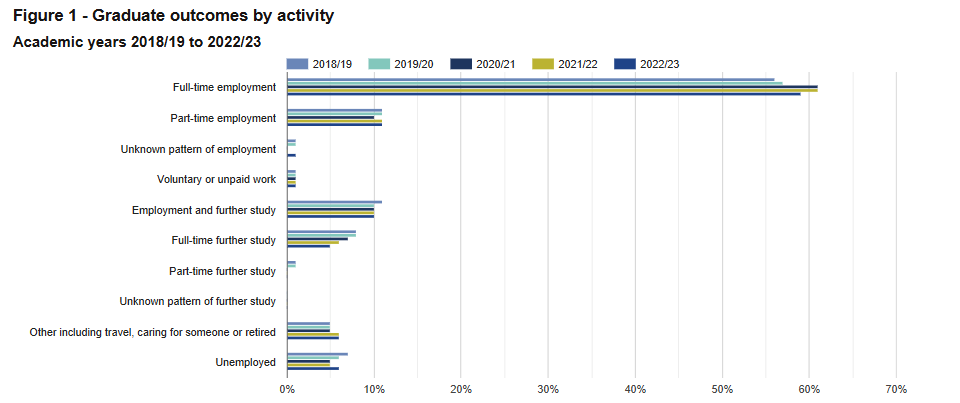Author
Dr Rebecca Robinson
Data Analyst (Higher Education Insight), QAA
Data releases
A few key data releases came out in July – NSS 2025 results, Graduate Outcomes for the cohort that graduated in 2022-23 and UCAS applicant data from the 30 June deadline.
National Student Survey 2025 results
On 9 July, OfS released NSS 2025 results, including dashboards giving provider level results and sector level characteristics data. Positivity was up across all themes this year with the biggest improvements in the sector’s weaker areas of assessment and feedback, student voice and organisation and management.
For more information, here’s a summary piece which we produced for QAA members looking at results by theme and signposting to useful member resources.
Graduate Outcomes 2022-23 release
The latest data on what graduates do after they qualify was also released this month. Graduate Outcomes is a census survey carried out 15 months after graduation and looks at the activity of respondents at that point in time.
Response rates for the survey have continued to decline, with overall response at 39% for the 2022-23 graduating cohort, down from 44% for the 2021-22 cohort.
In terms of activity, for all respondents the latest results show a slight drop in full-time employment (down from 61% to 59%) and full-time further study (down from 6% to 5%), and a slight increase in unemployment (up from 5% to 6%).

Image from HESA website
Medr published their analysis of the results relating to Welsh providers and graduates from Wales and Jisc analysis of the data puts the results in context with other labour market statistics.
UCAS 30 June deadline applicant data
UCAS published data on applicants and applications up to the 30 June main scheme application deadline.
The total number of applicants is up this year by 1.3% compared to last year. Looking at this by age shows the number of applicants is down across all age groups except those 18 and under. Despite the increase, the proportion of 18 year olds that made an application is down due to the larger overall population of 18 year olds this year (application rate down from 41.9% last year to 41.2% this year).
The proportion of the Welsh 18 year old population who made an application is 32.5%, lower than for the other nations (42% for England, 48.9% for Northern Ireland, 34.5% for Scotland).
The proportion of the 18 year old population who made an application in England varies by region with the highest rate in London (58.5%) and the lowest in the North East (32.8%).
Looking at international applicants, the highest numbers are from China (applicants up 9.8% to 33,870), India (down 11.3% to 11,310) and the USA (up 13.9% to 7,930).
By subject, the largest growth in number of applications is for engineering and technology (up 14.3%) while the biggest decrease is for computing (down 9.2%).
College student outcomes in Scotland 2023-24
Outcomes of full-time further education (FE) and higher education (HE) students in Scotland’s college sector were published by SFC this month. 67.1% of FE students and 66.9% of HE students successfully completed their course in 2023-24. Non-completion was 20.6% for FE students and 17.1% for HE.
Apprenticeships in England
DfE published data up to quarter 3 for 2024-25 on apprenticeships in England. Apprenticeship starts at all levels are up 2% compared to the same point last year, with level 6 and 7 starts up 13% (49,780 starts up from 44,060 in 2023-24).
HE fact sheets for Northern Ireland
DfENI released three higher education fact sheets in July. The age participation index – the number of Northern Ireland (NI) domiciled entrants to full-time undergraduate HE in the UK (aged under 21) as a proportion of the 18 year old NI population – was 49% for 2022-23, 5ppts down from 2021-22. This indicates a return to pre-pandemic levels after a peak from 2020-21.
Data on enrolments at NI HE providers by equality categories showed 14% with a reported disability in 2022-23 (down from 15% in 2021-22), 42% aged 25 or over (up from 39%) and 57% females (in line with previous years).
20% of first degree and postgraduate students gaining qualifications at NI HE providers did so in narrow STEM subjects in 2022-23, down from 24% in 2021-22.

Widening participation in higher education 2023-24
The latest data on progression to UK higher education by age 19 for pupils in English state funded schools at age 15 shows that the overall rate is 45.8% for 2023-24, down from 46.9% in 2022-23.
Looking at pupils eligible for free school meals (FSM), the HE progression rate was 28.9% in 2023-24. There’s a 20.1ppts gap between FSM eligible and non-FSM eligible progression rate. The FSM eligible HE progression rate differs by region: from 50.7% in inner London to 19.3% in the South West.
The HE progression rate for Black pupils is up to 63.3%. White pupils are the least likely to progress to HE (40.5% progression rate).
Monthly visa update
Following six months where the number of main applicant sponsored study visas were up compared to the same month in previous year, this month saw a drop: 27,900 applicants in June 2025 compared to 28,200 in June 2024.
Analysis in the sector
Unite Students applicant index
The fourth annual release of results from Unite Students’ applicant survey shows improvements across all themes compared to last year. The biggest improvement is in the employment theme which looks at the level of optimism around finding a graduate job and levels of work-related skills. International applicants are more confident than UK applicants across almost all themes.
Teaching quality is an important factor for international applicants – 24% of international applicants gave a free text response relating to teaching quality when asked about their first choice university compared to 4% of UK applicants.
SFC report on widening access 2023-24
Scottish Funding Council published their annual report on widening access, covering the 2023-24 academic year. The data shows that 16.7% of Scottish domiciled full-time first degree university entrants were from the 20% most deprived areas (SIMD20), up from 16.3% in 2022-23.
Looking across all Scottish domiciled undergraduate HE entrants, the figure is 19.2% from SIMD20 areas (up 0.5ppts) and for those in college based HE the figure is 24.8%.
2.4% of Scottish domiciled undergraduate HE entrants were care experienced in 2023-24 (2,030 students). The proportion of care experienced entrants has been increasing year on year.
Retention for SIMD20 and care experienced students are both consistently below the overall retention figure (89.5%) but saw improvement for 2022-23 entrants – by 3ppts for SIMD20 (to 86.1%) and 1.3ppts for CE (to 84.9%).
Share these insights
Please share this article with colleagues across your organisation – especially those who might find it useful in their roles. It’s easy to access with your institutional email and password. The more people who engage, the greater the benefit to your organisation – from stronger practice to better outcomes for staff and students.

